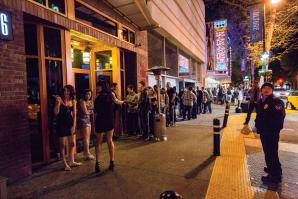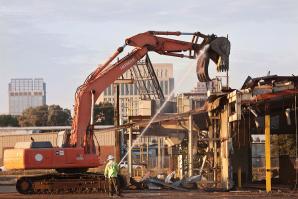City planners and private developers in Sacramento envision a downtown shopping and entertainment hub pulsing with revenue and pedestrians. The mind’s eye replaces vagrants with decorative park benches and rundown storefronts with shiny new facades. And rather than dispersing at sundown, restaurant patrons and theatergoers would linger into the wee hours.
Where there’s a will, there’s a way, but sometimes the when is the real kicker. The rejuvenation of J, K and L streets between 7th and 15th streets, referred to as the J-K-L corridor, has become a front-burner priority for Mayor Kevin Johnson. A number of projects have made progress the past few years — mostly on J and L streets — but K Street has had its share of setbacks, and currently there is little in the way of deadlines for near-future development.
In 2006 the Sacramento Redevelopment Agency issued a $100 million bond for downtown redevelopment. With some of that money, the agency purchased all of K Street’s 700 block and an “opportunity site” at 8th and K streets, according to Leslie Fritzsche, the Economic Development Department’s downtown manager.
The rehab history on K Street includes years of attempted land swaps, a fire and an eminent domain lawsuit, among others. Developer Joe Zeiden has owned the property at 708 K St. and 1111 7th St. for years, but a dispute mired in legal battles between Zeiden, the city and neighboring property owner Moe Mohanna has stalled development.
Zeiden, founder of the Z Gallery retail stores, has since raised his hand to develop 700 to 730 K St., and just before last October’s stock market tumble, the redevelopment agency locked in a $18.6 million deal with Mohanna and connected parties to develop nine properties.
K Street — from about 7th to 12th streets — has a nearly 40 percent vacancy rate.
It’s not much of an enviable task. This section of K Street — from about 7th to 12th streets — has a nearly 40 percent vacancy rate. Tack on the adjoining Westfield Mall where tenants only occupy about two-thirds of its storefront, and that’s a lot of retail to fill even in the best economy.
At an August meeting with Westfield LLC executives, Mayor Johnson expressed his aggravation at the company’s lack of investment in its downtown complex. And while the city can’t force Westfield to invest in or sell its property, the pressure is on for the company to come up with a sale or revitalization strategy.
“The challenge is the disparate pieces being bantered. K Street is really struggling, largely because there are so many stakeholders involved, and they are struggling in coming together and forming a consensus as to the overall brand direction: what they want K Street to be about,” says Michael Scott, a Folsom resident who is writing a book on the role downtowns play in civic connections. “Is it a retail destination? Is it an environment focused on downtown living? Should there be vehicular traffic, or should you capitalize on the proximity to light-rail?”
Even as K Street struggles, work has begun to transform neighboring J and L streets from gritty to groovy. The redevelopment agency is wooing a mix of local and national retail, restaurants, entertainment venues, residential developers and commercial interests. A streetscape plan includes paving, lighting and furnishings, which would be phased in.
In the spring, San Francisco nightclub operator George Karpaty is planning to open the doors at his three K Street bars and restaurants. One features an outdoor pizza oven and another boasts live mermaids.
Two other redevelopment projects along the J-K-L corridor have managed completion: the $6 million Firestone Building at 1531 L St., which houses the new de Vere’s Irish Pub among others; and the 500-room renovation at the Hyatt Regency.
Nearly a dozen other corridor projects have been enthusiastically discussed but are now sitting idle and disenchanted by budget cuts, indecision, downsizing and undefined completion goals.
Part of the struggle all along has been the divisive nature of project planning in Sacramento.
Part of the struggle all along has been the divisive nature of project planning in Sacramento, says Kevin Greene, policy manager for the Downtown Sacramento Partnership. It’s not pretty, and public meetings are often rife with arguments and antiquated thinking.
“Politically, there isn’t a lot of support for redevelopment spending,” Greene says. “In certain parts of the state it’s been abused, and we’re in a budget crisis. It’s a lower priority than funding education and social services.”
As part of this year’s budget process, the redevelopment agency took a $9.22 million hit from the state, which grabbed the cash for its own needs, ostensibly eliminating redevelopment funding for the remainder of 2009 and the start of 2010.
It’s a blow that knocked the wind out of an otherwise motivated agency that’s trying to tout the tangible benefits of its efforts.
“We feel like redevelopment dollars have made a difference on K Street. It’s created about 1,000 jobs and generates about $6 for every $1 of private investment,” Fritzsche says. Since 1986 the redevelopment agency has spent more than $475 million in federal and local dollars on projects in the Merged Downtown Sacramento Redevelopment Project area — Front to 7th streets between I and R streets.
About $95 million of the $100 million bond has been spent on such projects as The Orleans in Old Sacramento, development of the Citizen Hotel, revamping the Crest Theatre marquis and renovating the Cosmopolitan café and cabaret. The remaining $5 million has been allocated to the 700 and 800 blocks of K and to the Sacramento Waterfront Promenade. The redevelopment agency will also borrow about $5 million from its affordable housing budget to account for what was relinquished to the state.
Meanwhile, a detoured private investment march continues. Two major hotel projects have been proposed for K Street, but planners surmise the market could support just one.
At the corner of 8th and K streets, Le Rivage developer Bob Leach is envisioning a 400-room full-service hotel and convention center. He has until the end of November to present Sacramento officials with a viable financing package to build the $136 million high rise.
“As for the 1100 block of J, that’s really our black eye. … It’s a dark, blighted block.”
Kevin Greene, policy manager, Downtown Sacramento Partnership
Between 920 and 930 K Street, Jim Brennan and Tony Giannoni, the guys who developed the Marriott hotel at 15th and L streets, have proposed a new $43 million Courtyard by Marriott property. If approved, it could open in 2012. A couple of blocks away at 7th and L streets, the historic Marshall Hotel is being renovated as well.
“I am very aware of impacting our existing inventory, and we have been very careful about the type and size of this hotel,” Giannoni said at an October meeting with Downtown Sacramento Partnership’s Strategic Development Task Force. “This is a project that cannot take shape without city funding.”
The City Council will decide whether to approve either of the new hotel projects later this month.
“As for the 1100 block of J, that’s really our black eye. It’s the gateway to the city for those exiting Interstate 5. … It’s a dark, blighted block,” Greene says.
There is no financing for the area, he says, and the fully entitled Metropolitan project at 1001 J St., a planned 39-story mixed-use tower bySaca Development, is completely unfunded as well. The Cathedral Square condo project at 1010 L St., a proposed $250 million mixed-use high rise,has gone back to the drawing board of Sacramento-based St. Anton Partners, which is now considering downsizing the plan from 25 stories to something more feasible in the current market.
Meanwhile, oodles of money is being spent or set aside for consultants, surveys and reports, including a study to determine the ideal what and where for retail, an infrastructure study to assess the painful realities of developing around antiquated plumbing systems, a vehicle pilot study and a “downtown activation strategy.”
And while the money moves like molasses, developers balk and city leaders fuss, everyone seems to be doing it with an air of optimism. After all, the Citizen Hotel and Grange restaurant are bringing in rave reviews; regulars still flock to Temple coffee shop, Ella Dining Room and Bar and Esquire Grill. Things are happening on J-K-L; sometimes it’s just hard to recognize it over time. It’s something akin to waiting for water to boil.
“I’m a huge optimist. The infrastructure is in place. K Street is the epicenter of downtown Sacramento and if developed successfully could really serve as a catalyst for positioning Sacramento as a top-tier urban center,” Scott says. “But it may end up being that we hit a bottom in terms of our efforts before any regional traction begins to occur. It’s a shame in a capital city.”
Recommended For You

All Eyes on Kay
Beefed-up security steadies K Street
Sac Town revelers along K Street seem oblivious to new coordinated efforts by the Sacramento police, city officials, pubs, clubs and bars to deploy new layers of security and preparedness which, well, probably account for the harmony on this Friday evening in March.

Here Comes the Neighborhood
Area infill projects forge ahead
If everything goes as planned, the newest phase of the K Street redevelopment effort will open for business late next month off 10th Street, bringing a pizza place, dance club and “dive bar” stocked with costumed mermaids and mermen to the downtown mix.


